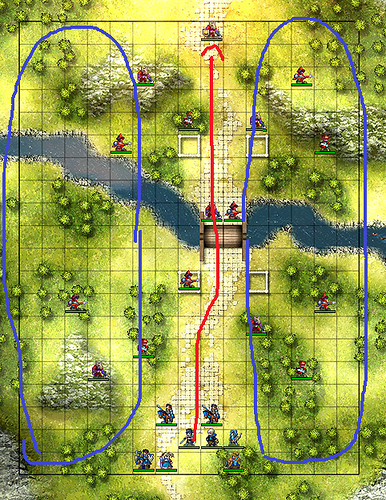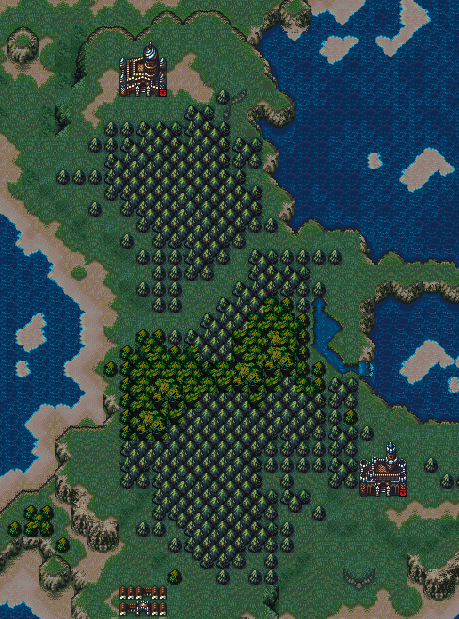Map Design and You
To preface this post, I would like to say this thread is NOT ABOUT MAKING MAPS LOOK NICE. Please keep that in mind. You can always make an ugly map look better later. It is more difficult to rearrange an already graphically fleshed out map.
Section I: Genning
To begin I’d like to address a big blunder in map design, which is using FEMapCreator to generate a map. My first piece of advice: don’t do this. Genned maps are awful 100% of the time. Some people like to use it just to gen annoying parts like mountains: this is workable, but overall a crutch, and as I’ve said, function should be prioritized over fashion. You don’t want to have to work around mountains just because you’re too lazy to make them look nicer later. Below is an example of a genned map. Notice how the map has no real flow or pattern to it.
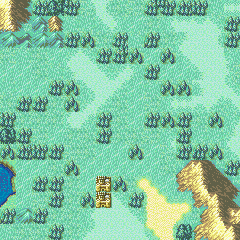
Notice the lack of any defining features.
Section II: Creating a Flow
So, how do I make my map have some “real flow or pattern to it”? Well, that’s quite simple. Start by drawing out a clear path from the start of the map to the end of the map. It can be as simple as opening up MSPaint and drawing a line through the course of the map. In this way, it can be very easy to find “dead space” - map space that serves no purpose because it has no relevance on the path from the start to the end. I’ll use an awakening map to demonstrate dead space, because it has a lot of it.
In red, we have the actual path through the map. The areas in blue are near useless to the design.
The simplest way to get rid of dead space is to reduce your map size. Don’t include extra space that isn’t necessary - every area should have a purpose.
Now, empty space is useless and bad, but this brings me to the opposite end of the spectrum, which is creating a map so tight that the player has no breathing room. The most common form of this is known as one-tiling. What is one-tiling? It’s where there is only one tile that can be traversed through a passageway. The most common examples would be a 1 tile door, a cracked wall, a snatch, a bridge and so on. One-tiling can also be exponential if you also add terrain to further impede movement. This is essentially the map version of a traffic jam, as units have no room to move and the player is stuck spending several turns cramming units through - the opposite of fun. There are several ways to avoid one-tiling, but the easiest is to just add a second traversable tile. Be careful as one-tiling can occur diagonally as well!
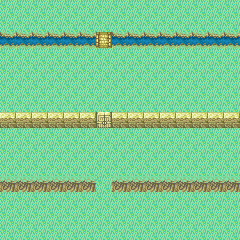
These are all examples of one tiling.
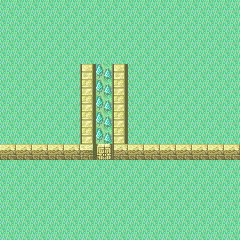
Imagine how annoying moving your units through this could be.
Just for the sake of example, here is a terrible map, chapter 12 from FE8, where not only is there an abundance of empty space in the form of mountains, but also constant one-tiling.
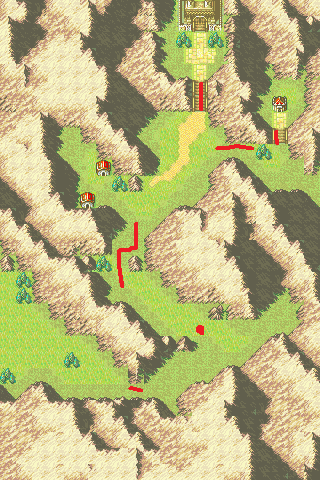
Red highlights show the one tiling. Notice the overabundance of mountain, including a 4 tile tall mountain at the bottom of the map for no apparent reason.
Section III: Avoiding Linearity
In the previous section, I talked about having a map flow, and creating a path through the map. This is all well and nice, but leaving it at that causes your map to become a bit too linear. While this may seem okay on paper, it reduces the replayability and flexibility of strategy of the map.
The solution? Well, there are a few. The first is side objectives. These don’t need to be complicated: an extra room with chests, a village to visit, NPCs to protect, units to recruit, and so on. Not only does this make the map more interesting, it can also reduce dead space and linearity. The important part about side objectives is to make sure they are SIDE objectives. They should incentivize the player to take a path they wouldn’t otherwise. I will show an example to demonstrate what I mean more clearly. This is chapter 4 of FE8.
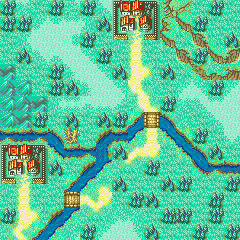
Your units spawn in the top left. Artur can reach the village turn one from his spawn location.
Note that the village on the bottom encourages you to try and send some units on a different path. This is correct. However, the village on top is in your direct path. Therefore it doesn’t become a side objective - visiting that village does not encourage any map exploration or deviation. I’m sure most players have visited this village turn 1.
The next solution is having separate paths through the map. Now, this one is more tricky. You need to be careful in balancing the two paths, lest one path be ultimately superior to the other and render it pointless (and thus dead space). You also need to consider the goal - do you want the player to split their group into the different paths, or do you want them to only use one path? If your intention is to split, I would recommend having two different side objectives along each path. In this way, the player is incentivized to go along both paths.
Section IV: Map Objectives
As I’m sure you’re aware, there are several different map objectives, the most common being seize, rout, defend and kill boss. I would like to preface by saying that seize and kill boss are near identical goals, and that seize only adds the precondition of also moving the lord to the boss. I will be giving a quick overview of what design should be like for various objectives.
Seize and Kill Boss: Should be more linear than other map types (but still not completely so). The goal is to move from point A to point B, so it should reflect as such. Avoid annoying terrain impediments such as the elevators and floating platforms in Revelation.
Rout: A more open objective. Since it is a requirement to reach all the enemies on the map, you are more free to create maps with open spaces. Avoid having space being too open, however, as this can lead to boring traversal. Awakening and Birthright had problems with this.
Defend: A more interesting objective that allows for more close quaters maps. Contrary to popular belief, choking a one tile passageway with a knight is not any more fun in a defend map then elsewhere. Remember to avoid one-tiling, as it holds up the enemy as much as the player. If you want the player to be incentivized to push through as opposed to stay still, use villages or chests. Chapter 10 of Conquest is one of the most infamous and well done examples.
This map encourages you to move forward to try and collect items from the villages.
There have also been cases I’ve seen of more strange objectives, but these usually come back to these 3 with minor additions. For example, escape maps are the same as seize maps with the addition of usually having enemies chase you through the map. (Conversely FE5 escape maps are just seize maps where every unit needs to seize.)
Section V: Other Common Blunders
By this point, you’re nearly a master map maker. However, there are still a few more problems I commonly see that need to be sifted through, so I’ll go over them in point here.
Fly-Skipping: This occurs when a map tries to use terrain to impede the player, but is unsuccessful because flying units can cross over it. This is most common with water and mountains. This can be avoided by either using terrain that fliers cannot cross, or adding in archers, wind magic, or ballista to dissuade the fliers.
Empty / Boring areas: These occur when there is a lack of different terrain in an area. This is easily solved by sprinkling in forests, forts, pillars or similar to said area.
Large Maps: A lot of people seem to get the idea that big maps are cooler, however these maps are usually ripe with dead space. As stated before in the dead space section, the solution is to just cut the size down.
Forest / Terrain Spam: This occurs when too many terrain tiles are placed in sequence, which causes player units to have to crawl through the area because of terrain costs. The solution is simply to remove some of the terrain.
Don’t be a Kaga.
Final Section: A tl;dr
Don’t gen maps.
Don’t make maps big and empty.
Don’t one-tile.
Don’t make your map play in a straight line.
Don’t throw “side-objectives” in the player’s face.
An Aside
If you’re having problems with map making, please feel free to DM me (or just post publicly and ask for help)! I’m always happy to see people making maps, even if it’s the hottest garbage I’ve ever seen. The best part is being able to take something from bad and make it into something fun. I would also really recommend playing your maps several times over and trying different strategies to get a feel for how your map plays out. Good luck with your maps!
